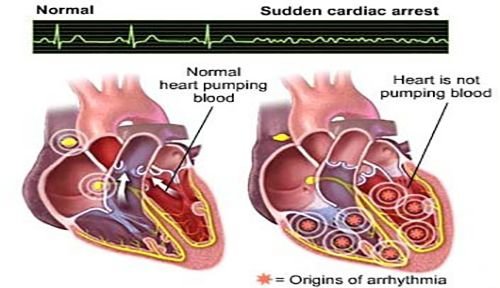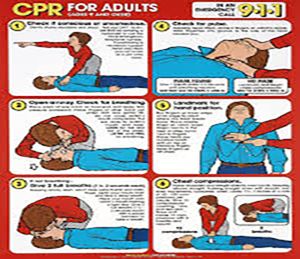HOW TO PREVENT CARDIAC ARREST

Cardiac Arrest may be defined as sudden and complete loss of cardiac function. There is no pulse; loss of consciousness and respiration ceases almost immediately, death is virtually inevitable unless effective treatment is given promptly.
Or
Cardiac arrest occurs when the heart suddenly stops beating, resulting in the cessation of effective circulation. All heart action may stop or a synchronized muscular twitching may occur. There is an immediate loss of consciousness and an absence of pulses and audible heart sound. The pupils of the eyes begin dilating within 45 seconds; seizures may or may not occur.
Common causes of sudden arrhythmic cardiac death
Coronary artery disease (85%)
• Myocardial ischemia
• Myocardial infarction
• Prior myocardial infarction with myocardial scarringStructural heart disease (10%)
• Aortic stenosis
• Hypertrophic cardiomyopathy
• Dilated cardiomyopathy
• Arrhythmogenic right ventricular dysplasia
• Congenital heart diseaseNon structural heart disease
• Adverse drug reactions
• Severe electrolyte abnormalities
Aetiology of cardiac arrest
- Ventricular fibrillation and pulse less ventricular tachycardia
• Myocarditis, Cardiomyopathy
• Electrolyte imbalance ( such as hypokalaemia)
• Ventricular arrhythmias
- Ventricular asystole
• Complete heart block
• Massive ventricular damage
- Electromechanical dissociation
• Hypovolaemia
• Tension pneumothorax
• Cardiac rupture
• Massive pulmonary embolism
Clinical features of cardiac arrest
Symptoms
- Loss of consciousness
- Cessation of respiration
- Coldness of the extremities
Signs
- Absence of pulse
- Uncountable BP
- No heart sound
- Dilated, fixed pupils
Emergency management of cardiac arrest
The management of the collapsed patient requires prompt assessment and restoration of the airway, breathing and circulation (ABC) using basic life support (BLS) with the aim of maintaining the circulation until more definite treatment with advanced cardiac life support (ACLS).
A. Basic life support: check responsiveness- shakes and shouts, if no response CPR- Cardio-Pulmonary Resuscitation should be given consists of the following sequence- Airway, breathing and circulation.
Common causes of sudden arrhythmic cardiac death
- Coronary artery disease (85%)
• Myocardial ischemia
• Myocardial infarction
• Prior myocardial infarction with myocardial scarring - Structural heart disease (10%)
• Aortic stenosis
• Hypertrophic cardiomyopathy
• Dilated cardiomyopathy
• Arrhythmogenic right ventricular dysplasia
• Congenital heart disease - Non structural heart disease
• Adverse drug reactions
• Severe electrolyte abnormalities
Aetiology of cardiac arrest
a. Ventricular fibrillation and pulse less ventricular tachycardia
• Myocarditis, Cardiomyopathy
• Electrolyte imbalance ( such as hypokalaemia)
• Ventricular arrhythmias
b. Ventricular asystole
• Complete heart block
• Massive ventricular damage
c. Electromechanical dissociation
• Hypovolaemia
• Tension pneumothorax
• Cardiac rupture
• Massive pulmonary embolism
Clinical features of cardiac arrest
Symptoms
- Loss of consciousness
- Cessation of respiration
- Coldness of the extremities
Signs - Absence of pulse
- Uncountable BP
- No heart sound
- Dilated, fixed pupils
Emergency management of cardiac arrest
The management of the collapsed patient requires prompt assessment and restoration of the airway, breathing and circulation (ABC) using basic life support (BLS) with the aim of maintaining the circulation until more definite treatment with advanced cardiac life support (ACLS).
A. Basic life support: check responsiveness- shakes and shouts, if no response CPR- Cardio-Pulmonary Resuscitation should be given consists of the following sequence- Airway, breathing and circulation.
Techniques of CPR

- Place the patient in supine position on hard bed.
- Heal of hand and interlock your fingers.
- Place the hand on the patient’s left sternum with arms straight, press down vertically.
- Compress chest 100 per minute ratio of 30 compressions with 2 breaths.
- Continue CPR: until emergency help takes over or you are too exhausted to continue.
B. Advance Cardiac Life support ( ACLS)
- Introduce endotracheal tube and ventilate the lung.
- Administer medication according to cause of cardiac arrest.
- Obtain an ECG to determine the type-
a. If cardiac arrest due to VF or pulse less VT treated with defibrillation.
• Defibrillation is firstly with 200 joules.
• If normal rhythm is not restored further shock 200 joules is given.
• If unsuccessful, a third shock of 360 joules is given.
• If unsuccessful, 1 mg of adrenaline i/v and a further 1 min. CPR are given before a further sequence of up to three shocks each at 360 joules.
b. If cardiac arrest due ventricular asystole
• Patient should be treated with defibrillated.
- Other associated care of patient with mechanical ventilation should be given.
Hey bro check it out Get your post resteemed over 90000+ followers and get upto $21+ SBD value Upvote. Go to This site: http://autobooststeem.tk/